I love the English language. My mother had serious disabilities from a dubious back surgery for a couple of years. I was a very active 3 ½ year old little boy. She was stuck with bed-rest and couldn’t even go down the steps into our backyard. (The little Demon with his first dog, Rusty. A contemporary photo) I 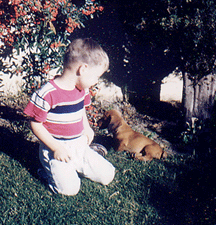 would taunt her as she stood on the steps and demanded that I come in the house. What’s a mother to do? Teach the little demon how to read. She would lie in bed and hold the book for me as we went from one word to the other. I loved looking at words and finding their secrets. I am the proud owner of a 1908 unabridged Webster’s, leather bound library dictionary, well worn. I still read it.
would taunt her as she stood on the steps and demanded that I come in the house. What’s a mother to do? Teach the little demon how to read. She would lie in bed and hold the book for me as we went from one word to the other. I loved looking at words and finding their secrets. I am the proud owner of a 1908 unabridged Webster’s, leather bound library dictionary, well worn. I still read it.
Whether that magical time caused me to love words or not, I cannot say. Is it my “reinforcement history” or was it genetic. Who cares? As I grew up I came to love the American version of English most. We have so many ways of describing the essence of a thing in a simple phrase. We got that from our ancestors who hailed from Scotland, Ireland and the Midlands of England. Simple, hard working people steeped in reality. We have added to that heritage in a grand fashion. Our power of metaphor and simile are unparalleled. For instance, a subservient person having been punished by someone more powerful is called a “boot licking dog” because that is how dogs actually behave when punished by their masters. A tiny amount of money is called “chump change” because chumps never have money because they are dimwitted fellows and easily lightened of their cash. If you don’t know what a chump is you can discover it by examining its synonyms…dupe, gull, patsy, pigeon, pushover, sap, soft touch, sucker and tool – all metaphors turned into words. Another term is “small potatoes” – meaning hardly worth harvesting because of their diminutive size. “Nickel and dime” has two meanings – one means of little value and the other means you are being bled at a small but never-ending rate. Strangely, all of these terms can be applied to a well-established sub-discipline of science called behavior analysis. I am quite familiar with how you might apply them to that activity. In the same way I studied words as a child, I have studied behavior analysis and behavior analysts for a long, long time trying to discern the secrets of their words and knowledge. I say strangely because our culture fairly worships anything that appears scientific. We have a deep and abiding belief that if science says it, it’s so. My grandfather would say that “ain’t necessarily so.” He was a man of great logic and also deeply rooted in reality. So, here it is. All laid out in well-worn but shiny Americanisms. All of the discoveries of behavior analysis can be summed up in three American compound words – chump change. Small potatoes. Nickel and dime. Here is the thing that behavior analysts crow about when citing their practical accomplishments – the invention of B.F. Skinner’s protege, Keller Breland…
Marine Mammal training. Marine mammal training is basically a novelty. Put a bunch of marine mammals in a huge bathtub and have teams of trainers teach them a half-dozen behaviors…that they routinely botch. Ultimately, it’s not important other than it wows the masses. As the crowds do not know the fundamentals of behavior it seems like magic – and like magic shows, the reality is not all that wonderful.
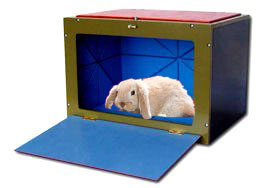 “Now you
“Now you 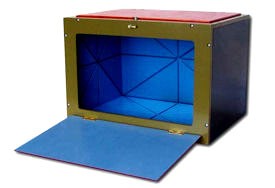 see it, now you don’t. “
see it, now you don’t. “
This is like showing a ball point pen to someone living in 1942 New Guinea. Once exposed, the magic looks pretty mundane. Oh, you had a machine hidden up your sleeve that delivers cards to your hands? I see, the bunny box actually had a mirror that made it look like there was no bunny but the bunny was behind the mirror. (Disclosure note: The one above sells for $179.99. Yes, it’s a trick box) Just as any educated person can decipher “magic” shows, I will reveal the “secret” behind marine mammal training so you can understand what small potatoes really is.
Sneeze Into a Kleenex:
Having a dog sneeze into a Kleenex is a great joke. When a friend comes over you complain that Buffy is allergic to something yet unidentified and say, “She makes us help her blow her nose five or six times a day.” Then keep your mouth closed. Your friend will look at you as if you are crazy. “No, I’m serious. Here, try it yourself.” Then you hand a Kleenex to your friend and Buffy dutifully shoves her nose in it and sneezes. Whatever you do, do not laugh or smile. Bottle up your laughter as you see what the word “stunned” really means. Your friend has no frame of reference to understand what just happened. That is why millions of people pay good money to see a dolphin or whale do an analogous behavior.
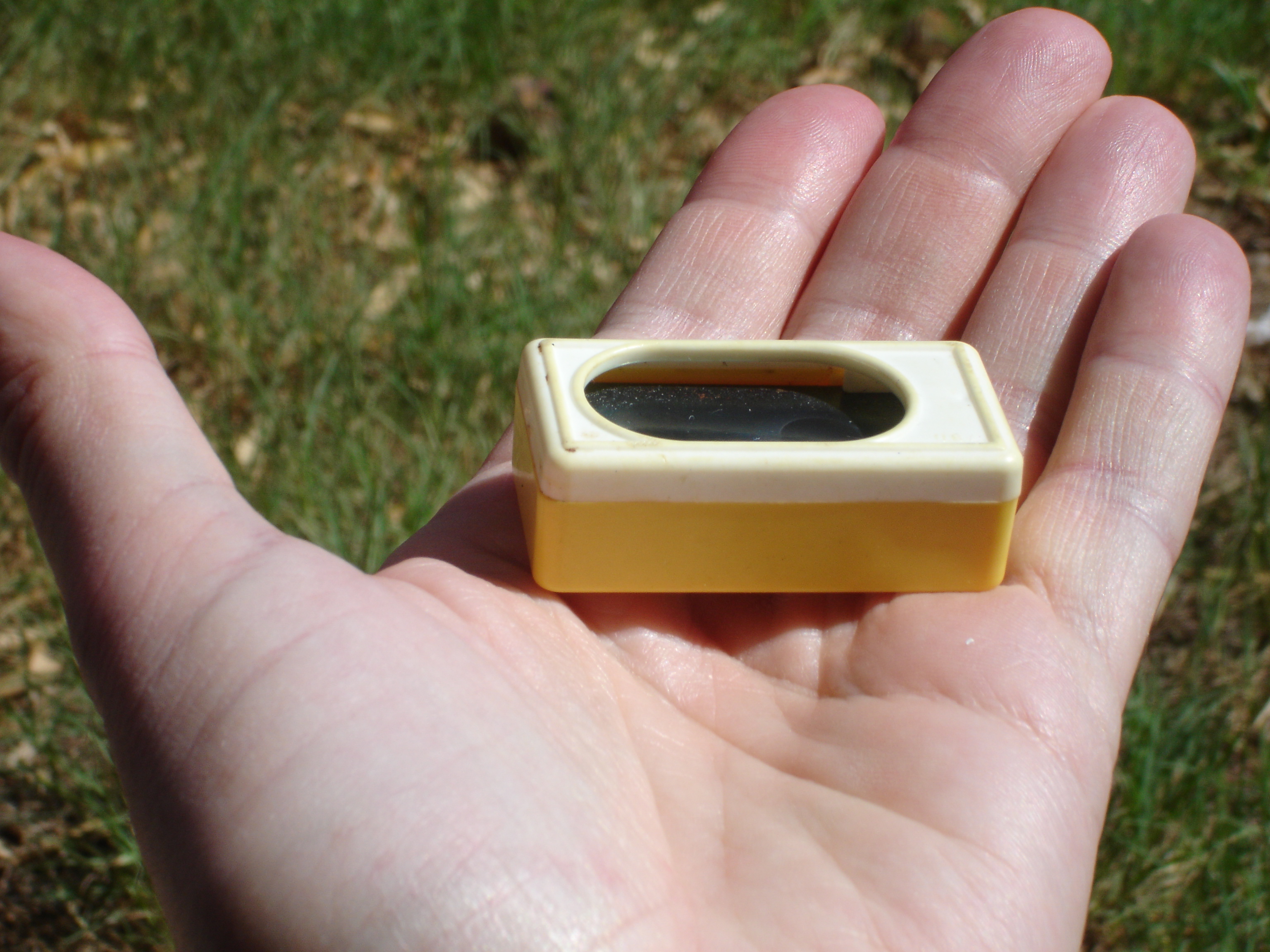
A typical clicker. You can get one for about $1.50 at PetSmart.
Prep Work:
The first thing to do is get a training clicker -even if you know nothing about them or hate them with a passion. Don’t go to great expense or get some fancy thing with push buttons or different sounds. Just get a standard box-clicker like the one at the left. Put the clicker in your pocket. Click it when the dog is about five or six feet away and not paying attention. Walk over and shove a treat in his/her mouth. Within a few clicks you won’t have to walk anywhere. The dog will come to you. End the session after about 15 treats.
Next session, put the clicker outside your pocket and behind your back with the dog in front of you at the same five or six feet. Click. Offer a treat. Your dog will come to you to get paid. The purpose of this exercise was to insure that you don’t have a dog who shies away from the clicker.
Getting Started:
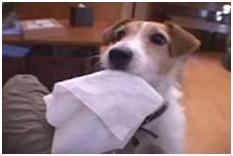 All dogs sneeze, eventually. You now have a new rule. During any training session, if your dog sneezes or even audibly blows air through his nostrils, click and treat. If you are in everyday life, say “good” if you don’t have a clicker and get up, go get a treat and deliver it. You’ve got an arbitrary 20 seconds. That is a long time. Repeat. The goal of this simple process is to connect the sensation of sneezing with a tangible consequence. Once paired, the dog will catch on that a sneeze can “cause” a treat. This is simply a matter of repetitive patterns. It is the same way a dog learns that the door-bell means something specific. The next part is a matter of learning to control this very natural process.
All dogs sneeze, eventually. You now have a new rule. During any training session, if your dog sneezes or even audibly blows air through his nostrils, click and treat. If you are in everyday life, say “good” if you don’t have a clicker and get up, go get a treat and deliver it. You’ve got an arbitrary 20 seconds. That is a long time. Repeat. The goal of this simple process is to connect the sensation of sneezing with a tangible consequence. Once paired, the dog will catch on that a sneeze can “cause” a treat. This is simply a matter of repetitive patterns. It is the same way a dog learns that the door-bell means something specific. The next part is a matter of learning to control this very natural process.
After you have generally increased the likelihood that your dog will sneeze during training you are going to ask for a behavior and then you are going to say the word “wrong” and not give a treat – even if the “sit” or “down” was executed perfectly. The dog is going to be seriously confused. It will offer some other behavior. Let that roll around for a few tries at “solving” the problem. Somewhere in that mix will be a sneeze. Likely not a big sneeze, but a hesitant, “maybe this will work” sneeze. Click and treat. Now, only click and treat for sneezes. You will see other behaviors drop away as the sneeze is temporarily the only thing the dog will offer. Once this is the case, end the session.
Next: Introduce the Kleenex:
On your next training session, continue with rewarding only sneezes. Arbitrarily, right after a click and while the dog is chewing up the treat, take a Kleenex and touch it to the dog’s nose. Wait for the next sneeze. This may take about 20-30 seconds. Be patient. As the dog eats the next treat, again touch the Kleenex to the dog’s nose. Wait for the sneeze, click and treat. Repeat. End the session after about 15 correct patterns with the Kleenex.
Start the next session by touching a Kleenex to the dog’s nose. Using the same process, as the day before, run about 20 repetitions. Done.
In the Real World:
Now start putting the trick in the real world. Have someone other than you touch the Kleenex to the dog’s nose. Now switch rooms. In a week you will have a very dependable behavior and you’re ready to try it on friends.
Conclusion:
So, now that you’ve accomplished the generally unfathomable, do you feel like you are at the top of the food chain of trainers? Did it take a team of people, hundreds of hours of training and constant practice to make it half-way reliable? No. However, the “sneeze” trick is exactly what marine parks do. Once you’ve done this, you have the secret of animal training, stripped down to its bare essentials. Get a behavior to happen. Use a marker and tangible food reward to strengthen the behavior. Make it temporarily the only behavior you will reward. Add a cue, give a show. Now put on a wetsuit and you can claim to be scientific.
2,000 years ago, Hannibal crossed the Alps with 38 war elephants. 1,000 years ago, Raja Raja built granite temples in India using the same beast. Billions of people survive because animals plow fields and do heavy lifting. Dogs are used to hunt, guide the blind, find explosives, attack bad guys, retrieve birds and a hundred other things. It’s been going on for 15,000 years. That ain’t chump change, that is the real deal. Claims of scientific superiority leave big questions about how that fits into this broader context. Any comparison comes up with those three shots of honest American criticism – chump change, small potatoes and nickel and dime. If this realization upsets you, I suggest you teach your dog to become intimate with Kleenex and ask it to fetch – using the tried and true methods of practical dog training. You see, the elements of teaching any behavior lies in the beast and have been known for millennia. All training is “operant conditioning” because that is what “training” means. The only difference is the pretentious nature of chump change scientists practicing self aggrandizement while ignoring the accomplishments of “a nice chunk of change”, “big potatoes” and a “big bank roll.” Oh, the other difference is “training” is two syllables and “operant conditioning” is seven. Big deal.
